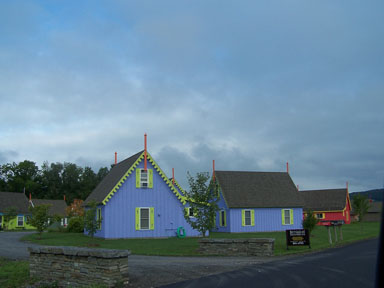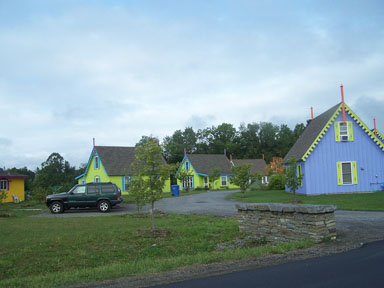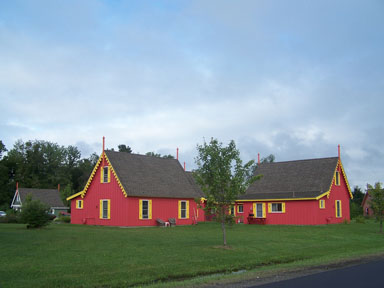August 30, 2010
Another zoning boundary case
Near the end of the July meeting on the proposed zoning, builder Bruno Schickel asked why the tables in Sections 605 and 606 set a limit of four units per acre on individual single-family homes. Other approaches in those tables, which I thought allowed far too much density period, allowed up to ten units per acre.
While I understood (though disagreed with) most of Schickel's other points, that one left me wondering. The Fall Creek neighborhood in Ithaca is about 5 or 6 units per acre, and I'm pretty sure that Corning, where I grew up, stays below 8 units per acre when single family homes are the model. I understand that smaller (and taller) houses can work very well on smaller lots, but what might tempt us to experiment with such a thing? Dense housing developments in Dryden are generally - well, they're generally not especially attractive.
While looking around , though, I found a link to one of his more striking projects, Boicevillle Cottages in Caroline. It's a dense little neighborhood of distinctive houses surrounded by largely empty fields. As both Tompkins Weekly (page 2) and today's Ithaca Journal report, he's planning to build another 37 of those on 11 acres.
That's only 3.3 units per acre, though judging by the comments on the Ithaca Journal article, it's too much for some people:
The tree huggers love that type of layout; clustered houses around a commons area, or in modern green terminology, "open space". Its the same stuff the Eco-Villagers do, and its a throwback to the Puritan days when you were expected to live around the commons area so your neighbors could keep an eye on your daily activities to ensure you weren't falling into godlessness. - BFranklinsGhost
Maybe those are the reasons Dryden zoning prohibits more than 4 single-family homes per acre?
No, not really, especially as these are rental units anyway. It's worth considering a hypothetical, though. Saunders Greenhouse is for sale, just three doors up the road from me. The listing, citing current zoning, says that:
Zoning call for up to 135 units, but will be affected by grade issue.
Those are some serious grade issues, and the proposed zoning would limit it to more like 90 units, but could I imagine a development of these kinds of 800-1500-square-foot cottages there? Without wincing?
Yes, I can - though maybe the paint colors on the houses visible to the road and the neighbors could be, maybe, just a little more muted?
The problem, though, is that most developers aren't Bruno Schickel. It's not just that they paint houses in duller colors or wrap them in vinyl siding, but that they set out to create ordinary dullness in ways that will net them maximum profit. Schickel's creations, at least the ones I've seen and heard about, seem to get a lot more thinking before they start building. It's not just architectural madness, funky trimmings and such, either - Boiceville Cottages definitely sets out to create a community, even if it's a community in an isolated location. (It doesn't attempt to be Ecovillage, either.)
To run the Saunders Greenhouse hypothetical another way, I don't have high hopes that most developers of large-scale apartment complexes would put anything on that land I'd regard as something other than blight. I get a headache just imagining a Varna II style layout there, maximum boxes made possible by massive retaining walls.
I suspect there are other people in Dryden who think I'm crazy for liking Schickel's cottages, and who'd like to make sure that even that can't happen. From my perspective, though, I could agree with Schickel's questioning the rules - if most developers created work like his.
Since they don't, however, I think even the rules Schickel finds too constraining to be too loose.
Posted by simon at August 30, 2010 5:03 PM in Ithaca Journal , Tompkins Weekly , planning and zoningNote on photos


